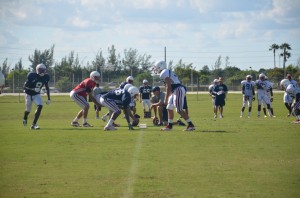
Last season, linebacker David Hinds would barrel into opposing offensive lines with little chance of success at reaching the quarterback or ball carriers in the backfield. This season, Hinds, along with the rest of the Owls defense, is looking forward to causing trouble for opponents thanks to their new weapon — the 3-4 defense.
FAU is making the switch from a traditional 4-3 to a 3-4 defensive scheme, in the hopes of countering the spread offense.
“There is no doubt in my mind that this is going to make us better,” Hinds said. “Last year we were a conservative team when it came to blitzing and zone coverages. The 3-4 is a run-stopping and a blitzing defense to confuse the offensive line and quarterback. We have more freedom than in the 4-3.”
In a 3-4 defensive alignment there are three down linemen at the line of scrimmage and four linebackers, as opposed to the four linemen and three linebackers of a 4-3 scheme.
“It puts more speed on the field,” defensive coordinator Kurt Van Valkenburgh said. “You take away one defensive lineman and replace them with a linebacker. We feel it will give us an advantage in our pressure packages because it’s a little harder [for the offense] to determine who is rushing and which of the four could be coming. It’s a defense that disguises itself until the last possible second.”
In 2010 the defense was unable to stop its opponents, giving up 401.3 yards per game while allowing opponents 29.2 points per game. Although the unit struggled all season, news of the change in the offseason came as a surprise.
“At first we sat there and were like ‘we gotta switch?’ because we were so used to the 4-3 and we were just starting to figure out how to fit into that,” Hinds said.
“It puts us as a team in better positions to win games,” senior Kevin Cyrille said. “In scrimmages we’ve been forcing a lot of turnovers. Our defensive line will have a lot of movement and face double teams, but we have the right guys on the outside in the right places to make big plays.”
The 3-4 will give Van Valkenburgh and his defense more flexibility when it comes to showing their hand on the field. In 2010 the Owls had little success making stops on the field, and now, at least in the few offseason scrimmages, the defense has been the one constant on the field as they have forced 12 turnovers in two games against the offense.
“We had some guys change positions in the offseason and it’s still a work in progress,” Van Valkenburgh said. “Most of our turnovers in the scrimmages were earned. We’ve got a long way to go to be where we want to be, but I think their intensity level is up from a year ago and they’re looking to make plays more than they did a year ago.”
Although the Owls have struggled on defense in recent years, that wasn’t the reason for the change. Teams in college football are relying more on the spread offense, which tries to thin out the defense and spread them out. This has left the Owls in the dust in previous seasons, and Van Valkenburgh feels now is the right time to make the change.
“It was a number of reasons why we switched,” Van Valkenburgh said. “The style of offense we see, our personnel, and wanting to become a team that had more speed and versatility on the field.”
The 3-4 defense will be a challenge for the Owls this year, but with the numbers the 2010 unit put up, improvement may not be too difficult for the 2011 squad to attain. Last season the Owls defense tied for 66th in the nation for interceptions with only 11, and had 20 sacks, good enough for 86th.
With the new system in place, the defense is looking to force opposing offenses to become one-dimensional by stuffing the run and making them pass.
“If we can make plays up front, we’re confident that the rest will fall in place as we have practiced all offseason,” Cyrille said. “When we stop the run in practice, we eventually force turnovers, and in games that will put our offense and our team in good positions to score points and win games.”
By throwing in a new defensive playbook, adding some blitz packages and moving linemen around, Van Valkenburgh and his players hope they have found the recipe to a winning formula. It also helps that this scheme is being used by some of the best colleges in the country, as well by as many teams in the NFL.
“I’ve seen it in the NFL, but I hadn’t played in this type of defense before,” Cyrille said. “It’s good to know that what we’re doing now can help win games here and also to make it to the next level.”



















